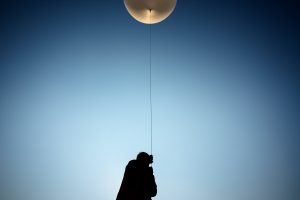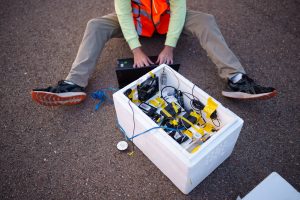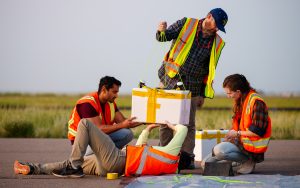
Study asks: Can cell phone signals help land a plane? – News Releases
Summary
Researchers from Sandia National Laboratories and Ohio State University are developing a backup navigation system for aircraft that could work when GPS is unavailable. The system would use "signals of opportunity" - existing radio frequency waves from cell phone towers and non-GPS communications satellites - to calculate an aircraft's position and velocity.
Key points:
- - The team is conducting high-altitude tests using weather balloons that carry specialized antennas up to 80,000 feet to collect signal data
- - The research aims to address vulnerabilities in GPS, which can be disrupted by jamming or spoofing
- - Preliminary findings suggest they detected cell tower signals at 82,000 feet, which could expand possibilities for alternative navigation
- - The system would use the Doppler effect to measure radio wave characteristics and calculate position
- - This is not meant to replace GPS but to serve as a backup when GPS is compromised
The research is supported by Sandia's Laboratory Directed Research and Development program, and the team presented their initial findings at the Institute of Navigation GNSS+ conference in Baltimore.
Study asks: Can cell phone signals help land a plane?
Sandia Labs, Ohio State look to the skies to protect aircraft against GPS outages
ALBUQUERQUE, N.M. — Dangling from a weather balloon 80,000 feet above New Mexico, a pair of antennas sticks out from a Styrofoam cooler. From that height, the blackness of space presses against Earth’s blue skies. But the antennas are not captivated by the breathtaking view. Instead, they listen for signals that could make air travel safer.
Researchers from Sandia National Laboratories and Ohio State University are taking experimental navigation technology to the skies, pioneering a backup system to keep an airplane on course when it cannot rely on global positioning system satellites.
More than 15 miles below the floating cooler, cell phone towers emit a steady hum of radio frequency waves. Hundreds of miles above, non-GPS communications satellites do the same.
The idea is to use these alternative signals to calculate a vehicle’s position and velocity.
“We’re not trying to replace GPS,” Sandia lead researcher Jennifer Sanderson said. “We’re just trying to assist it in situations where it’s degraded or compromised,” which can lead to dangerous situations for pilots and passengers.
The team presented its preliminary data at the Institute of Navigation GNSS+ conference, held from Sept. 16-20 in Baltimore. The research is supported by Sandia’s Laboratory Directed Research and Development program.
The case for a GPS backup
There is no question GPS is still the gold standard for navigation. It’s fast, precise and reliable. Which might raise the question: Why are researchers developing new navigation methods?
“I worry about relying too heavily on it without a backup,” said Sanderson, an expert in navigation algorithms.
GPS, she said, has become part of the fabric of our modern, technological world. As a society, we are constantly plugged into it, whether we are landing a plane, driving through town, mapping crop yields or timing transactions in stock markets. This reliance has researchers like Sanderson concerned about the consequences if the connection is disrupted.

“The impacts of losing GPS could be felt throughout society,” she said. Disruptions to GPS are not uncommon. Pilots flying near conflict areas are increasingly likely to lose GPS or discover it is unreliable. The longer they fly without GPS, the higher the risk of accidents.
“Commercial GPS receivers are susceptible to a couple different threats, one being jamming,” Sanderson said. Jammers, devices that overwhelm receivers with meaningless signals on GPS frequencies, are illegal but commercially available.
Another problem, she said, is spoofing, which involves using a fake signal to mislead receivers into believing they are in a different location. The technique is no secret, as gaming communities use it to cheat in location-based games like Pokémon Go.
“There are actual apps you can download that allow you to spoof your location, and entire subreddits dedicated to showing you how to use it for various games,” Sanderson said.
While spoofing a game may be relatively harmless, Sanderson emphasized it can have real-world consequences when directed at a vehicle. Pilots might not be able to tell if a signal is spoofed or genuine, leading them in the wrong direction.
Project studies signals-of-opportunity at high altitude
Sanderson’s idea of navigating using non-GPS signals that happen to be nearby is not entirely new. Scientists refer to it as “signals of opportunity” but have primarily studied it on and near the ground. It has been proposed as a way for autonomous vehicles to navigate through urban canyons, where GPS signals are blocked by towering buildings.

However, it is not a simple task. Instead of extracting time and location information from a GPS signal, receivers of signals-of-opportunity sometimes measure the physical characteristics of radio frequency waves instead.
For example, they can use what’s called the Doppler effect. Radio waves from a satellite moving toward a receiver become compressed as they travel, while radio waves from a satellite moving away become stretched out. With some advanced mathematics and enough signals, scientists can determine the source of the signals and calculate the receiver’s position.
Sanderson and her team are studying signals-of-opportunity navigation at high altitudes. If they can collect signal data from the stratosphere, they may be able to develop a way to guide vehicles, such as aircraft, using a network of atmospheric radio frequency waves. “So, we strap our payloads to these weather balloons and launch them into the air,” she said.
The payloads, which consist of electronic packages attached to a pair of antennas and bundled into an insulated foam cooler, hold the key to understanding signals high above the clouds. Satellite signals are expected to be strong, but there may be dead zones due to the cone-shaped transmission pattern that narrows closer to the source. Satellite coverage over rural areas, like much of New Mexico, may be too sporadic to be useful. The strength of cell tower signals can be calculated theoretically, but it needs to be characterized to be useful in a real-world situation.
“So far, the highest altitude we’ve reached is about 80,000 feet. In comparison, other studies we’ve seen have focused on 5,000 to 7,000 feet.”
Processing data is the next step of team’s scientific journey
As researchers continue to process their first batch of data, they look forward to new milestones and new challenges.
“The not-sexy but very important side of navigation is understanding all your error sources,” Sanderson said. “My goal is to have a robust dataset to develop algorithms for real-time systems, enabling hardware tests using actual live-sky data.”
Eventually, a functional navigation system will need to match signals to their transmitters in real-time and then calculate position and velocity relative to those sources. However, in this early stage of the research, her team is manually matching received signals to nearby satellites using reference data.
“It can be quite tedious. So, one big aspect we need to address is automating this process,” she said.
Despite the challenges, she remains optimistic.
“While we are still processing the flight data, we believe our preliminary findings indicate that we detected cell tower signal beacons at our peak altitude of about 82,000 feet. If these signals are clean enough for navigation, it will significantly change what we thought was possible for alternative navigation,” Sanderson said.
This algorithm can make satellite signals act like GPS

Researchers have developed an algorithm that can “eavesdrop” on any signal from a satellite and use it to locate any point on Earth, much like GPS. The study represents the first time an algorithm was able to exploit signals broadcast by multi-constellation low Earth orbit satellite (LEO) satellites, namely Starlink, OneWeb, Orbcomm and Iridium.
Researchers found that by listening to the signals of eight LEO satellites for about 10 minutes, their algorithm could achieve unprecedented accuracy in locating a stationary receiver on the ground and was able to converge on it with an error of only about 5.8 meters.
The research, led by Zak Kassas, a professor of electrical and computer engineering at The Ohio State University and director of the Department of Transportation Center for Automated Vehicles Research with Multimodal AssurEd Navigation (CARMEN), was presented last week at the IEEE/ION Position Location and Navigation Symposium (PLANS) 2023 conference in Monterey, California. Along with Ohio State PhD students Sharbel Kozhaya and Haitham Kanj, the paper, which demonstrated the first ever exploitation of unknown OneWeb LEO satellite signals, won the conference’s Best Student Paper award.
The researchers did not need assistance from the satellite operators to use the signals, and they emphasized that they had no access to the actual data being sent through the satellites – only to publicly available information related to the satellites’ downlink transmission frequency and a rough estimate of the satellites’ location.
From transportation to communication systems to the power grid and emergency services, nearly every aspect of modern society relies on positioning, navigation and timing data from global navigation satellite systems (GNSS), or GPS, that orbit the Earth. Despite this, because GPS system signals are weak and susceptible to interference, they can often become unreliable in certain places such as indoor environments or in deep urban canyons. In addition, GNSS signals are spoofable, which poses serious security risks in safety-critical applications, such as aviation.
In the long term, such complications could lead to a number of navigational and cybersecurity issues, especially as virtually all of our current systems rely heavily on GPS, Kassas said. Technologies on the rise, such as autonomous vehicles, he noted, are beginning to amplify the limitations of our current GNSS systems.
“It’s becoming more pressing to find civilian and military alternatives to GPS, whether as a backup or in the case when GPS isn’t there whatsoever,” said Kassas.

This study builds on previous research by Kassas’ lab that solely used six SpaceX satellite signals to pinpoint a location within 10 meters of accuracy, which was recently reduced to 6.5 meters.
“The Starlink study scratched the surface of what is possible,” said Kassas.
His work suggests utilizing signals from LEO satellites as an alternative for humans’ positioning, navigation and timing needs, as they reside about 20 times closer to Earth compared to GNSS satellites, which reside in medium Earth orbit – a little more than 20,000 kilometers above the planet. According to Kassas, the technology could potentially usher in a new era of positioning, navigation and timing.
“We are witnessing a space renaissance. Tens of thousands of LEO satellites will be launched into space over the next decade, leading to what is referred to as mega-constellations,” he said. “Signals transmitted by these satellites will revolutionize numerous technologies and benefit scientific inquiry in fields such as remote sensing.”
What also makes the study so different from all other attempts at creating an alternative to GPS is, unlike previous studies, this algorithm doesn’t reverse engineer the signal, said Kassas.
“Our algorithm is agnostic to the LEO constellation,” said Kassas. “Our receiver can listen to virtually any satellite signal, trains on the data it’s receiving on-the-fly, then deciphers certain features of the signal in a way where we can reconstruct what they are transmitting into location data.” To demonstrate the team’s new approach, the team applied the algorithm to four different LEO satellite constellations: Starlink, OneWeb, Orbcomm and Iridium. The algorithm cracked all these signals, with virtually no prior knowledge about what is being transmitted.
Additionally, their algorithm is so sophisticated that the researchers were also able to estimate where the satellites are in space. In order to use the satellite to position ourselves, we need to know where the satellite is located. “That’s a very challenging problem because LEO satellites don’t normally broadcast their location, and our publicly available estimates of where they are is off by a few kilometers,” said Kassas.

During a stationary experiment to test how the signals worked as an accurate positioning system, researchers set a ground receiver's initial position estimate to the roof of an engineering parking structure at the University of California, Irvine, a spot more than 2,000 miles away from its actual position: the roof of Ohio State’s ElectroScience Laboratory (ESL) in Columbus, Ohio. Using the satellite constellations to guess where exactly in the country the receiver actually was, the algorithm was only off by about 5 meters.
In another experiment, the researchers tested how the algorithm would fare on a moving vehicle, and mounted the receiver onto the top of a car. First, they used today’s navigation technology, which relies on a GPS receiver coupled with an inertial navigation system (INS). They navigated for about 100 meters before cutting GPS off, after which they drove for nearly a kilometer. They found that by relying on today’s GPS-INS system, they were said to be located about 500 meters away from their true location, but with their algorithm, they were found about 4.4 meters away. “Our result showed that our system is getting close to what you can do with GPS today,” said Kassas.
Although a patent has been filed on the algorithm, the team does plan to continue evolving all of the algorithm’s technical abilities, said Kassas.
“GPS is a very mature system that we trust with our lives,” he said. “To be able to trust new types of signals with our lives, there will have to be more studies on their accuracy, integrity and continuity.”
Other Ohio State co-authors were ESL students Joe Saroufim, Samer Hayek and Mohammad Neinavaie. The work was supported by the Office of Naval Research, the Air Force Office of Scientific Research, the Department of Transportation and the National Science Foundation.


No comments:
Post a Comment